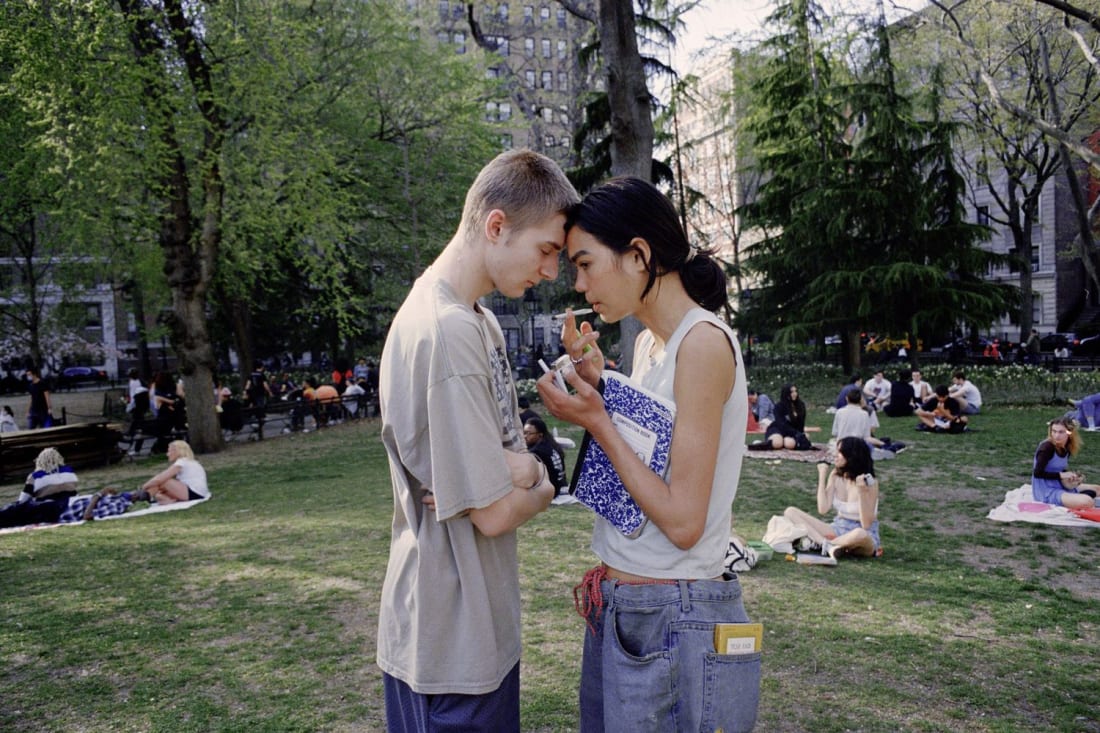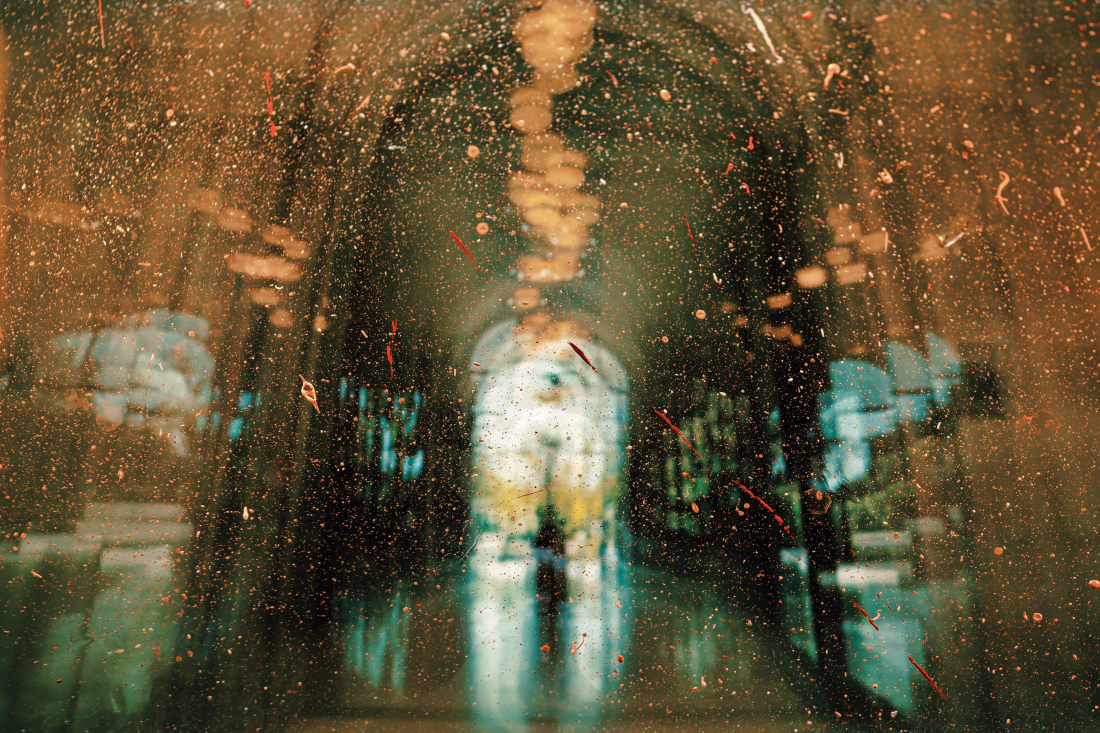Psychedelia and dancing elephants: the history of trippy kids' shows
Some kids shows are a trip, here’s the journey they’ve been on
Some kids shows are a trip, here’s the journey they’ve been on
A cosy evening at home, watching trippy cartoons. With friends, alone, sober, or high. It doesn’t matter. Mind-bending colours, imploding sequences, morphing images, wild music, nonsense. It is always a feel-good time. Perfect for the hibernation szn, for escaping, and for feeling a little like a kid again.
But who put the psychedelic in the cartoon?
Walt Disney Productions did. But let’s go back a little further, time-wise. Geographically, we’re staying in California. A couple years ago, a group of archaeologists from the University of Central Lancashire were excavating Pinwheel Cave in Southern California, about 50 miles northeast of Santa Barbara. The cave gets its name from a large pinwheel-shape that someone drew in red, on its ceiling. The cave was occupied about 500 years ago, and has quite a few drawings inside.
They also found a lot of chewed up plant, which had been pushed into the ceilings of the cave. This raised hope that the team could collect and analyse DNA. They weren’t able to. However, they were able to figure out that the chewed up goods were a psychoactive flower, Datura. Speaking to science.org, David Robinson, leader of the excavation said, "I was like, ‘Wow, we found the smoking gun of hallucinogens at a rock art site,”’ upon making the discovery.
Those people were getting high and making art 500 years ago, but there’s some evidence that suggests psychedelic-art intersections have been around for far longer. There are cave paintings in Algeria, carved into rock roughly 9000 years ago, which people claim suggest psychoactives were taken (because the drawings are trippy) – but there’s no evidence suggesting it was people making art high as opposed to drawing their dreams, or something. Still, we know people were smoking weed at least 2,500 years ago, so maybe they were doing a little drawing too.
We’ve been creating art and tripping for a while, either way. But in terms of cartoons, it all started with Walt Disney (and the rest of his team, Walt himself was a production supervisor in this), with the release of Fantasia, back in 1940.
The entire film is wild, it consists of seven completely unrelated narratives all set to classical music directed by Leopold Stokowski, a very famous conductor at the time. The most famous is 'The Sorcerer's Apprentice', which was Mickey Mouse’s return to the big screen. It’s the only segment with an actual story to it, which is probably why we remember it. The rest of the film is just a complete trip, a completely off-the-wall experiment which cost so much that it only just made a profit despite it still being considered one of the greatest animated films of all time. One scene took six entire days to film, with crew taking shifts to oversee the recording. The scene consisted of over two-hundred and seventeen feet of film, which is about half the height of the tallest pyramid.
And the history of trippy cartoons isn’t just visual. As alluded to, auditory weirdness is very much part of things, and so it is in Fantasia, where much of the movement of the characters is choreographed to the classical music. Watching it, at times, you feel like you can see sound. Isabel Morse Jones, a critic for the Los Angeles Times who went to the premiere, called the soundtrack a "dream of a symphony concert".
Adding to the vibes at the time, the soundtrack was the first commercial film shown in stereo, which allowed sound to pan from one speaker to the other for the first time. It would have felt a bit like spatial audio and surround sound do to us now, as most songs are recorded using stereo today.
We’ll skip a few decades now, because Fantasia (and the Pink Elephants on Parade sequence from Dumbo 1941) are early as heck. In June 26, 1959, Disney released a short film starring everyone’s favourite pantless duck: Donald in Mathmagic Land. What’s happening here? Who knows. The 27 minute short starts with Donald, holding a shotgun, exploring a mysterious forest. Then it becomes an acid-laced fever dream based around mathematic principles. It is actually, technically, educational. But it is also fantastically trippy viewing.
And yes, those pink elephants are intentional. "Seeing pink elephants" is a euphemism for hallucinations, and has been since the early 1900s. An alcoholic character in Jack London's 1913 novel John Barleycorn is said to hallucinate "blue mice and pink elephants", nearly three decades before Dumbo used them. Pink elephants do exist in real life too, though they’re very rare.
1968, a year after the summer of love: hippy era. The vibes definitely seeped into the animations coming out. Winnie the Pooh’s nightmare sequence in Winnie the Pooh and the Blustery Day, is really quite trippy. A year later, the team behind The Pink Panther Show (not Disney for once!!!) made an episode called ‘Psychedelic Pink’ which involves the pink panther visiting a bookstore, but the entire episode is full of psychedelic ‘hippy’ looking visuals and surrealist moments. And in 1970, while not trippy as such, The Aristocats had a few booming and raucous musical numbers which, if not trippy, are not at all sober looking. It’s jazz, you know.
And then came the 1970s, a really trippy time. Most cartoons have a funky element or five by now, but one is more blotted with references than the rest: Scooby-Doo, Where Are You! Shaggy alone, who was definitely, definitely stoned out of his mind the entire time, is enough to show this. Add to that the ghosts, ghouls, munchies, psychedelic as hell Mystery Machine, and you know that despise the creators saying it’s a coincidence, there is psychedelic influence in bounds. Perhaps shaggy made the whole thing up in his head while high (this is purely speculation). Though not confirmed by the creators, we can also see that ‘scooby snacks’ are slang for quite a few drug terms, which came first? Probably the show, but still, it is psychedelic. It just is.
With prep culture, things could have been seen to die down in the eighties, but in 1989 along came The California Raisin Show. Yup, we’re back in Cali’. The characters were originally created for adverts by the California Raisin Advisory Board, but ended up as a television show too. Episodes are situational, plot examples include: “Red is given shoes with a mind of their own.” and “The band plays at a futuristic club, only to discover they're being launched into outer space!”
By the 90s, there’s a second golden era of trippy ‘toons. Here the shows became the weird, comedy-leaning cartoons that we tend to still enjoy and associate with psychedelic cartoons today. We also see cartoons for not-children: The Simpsons initially (1989), but not too long after there’s South Park, Futurama, and Family Guy. Much of the influence can be traced back to Ren & Stimpy, one of the first shows to be broadcast on Nickelodeon (we’re firmly out of the Disney dominance now, btw). It's about a zany chihuahua and a not super clever cat, who go on a host of unusual adventures together.
And then in May 1999, there was a show featuring a sponge, living in a pineapple, “under” the sea, wearing a shirt and tie. Yes, it’s SpongeBob SquarePants, Nickelodeon’s longest-running (and probably most popular) animated series. Stephen Hillenburg, the creator of Spongebob, has been called “a trippy ass dude” by people on Reddit, who point to his other works. He made two short films called Wormholes while at California Institute of the Arts, in 1992. They're WILD (and do look a bit like Spongebob visually).
And then we get contemporary. Today, our world is rich with weird, wonderful, and far out shows. Adventure Time (which Nickelodeon actually rejected), Rick and Morty, and shows designed for children with names like Kipo and the Age of Wonderbeasts, which first aired in 2020. Thanks to streaming services and generally being able to watch shows from around the world online, we’ve also been able to lean into some trippy creations from further afield.
Three classic films from Studio Ghibli come to mind as trippy. Akira, My Neighbour Totoro, and of course, Princess Mononoke. The reason these, and many cartoons have a trippy quality, is because psychedelics make us see the world a bit like children do. Of course, this is the beauty of most animated media: it pleases children and adults alike.
The next time you’re chilling, wondering what to watch to help elevate your mood into something a little trippier, to escape the work and the stresses of the day, remember psychedelic cartoons. From 1940’s Fantasia to the contemporary, there’s plenty to enjoy.



